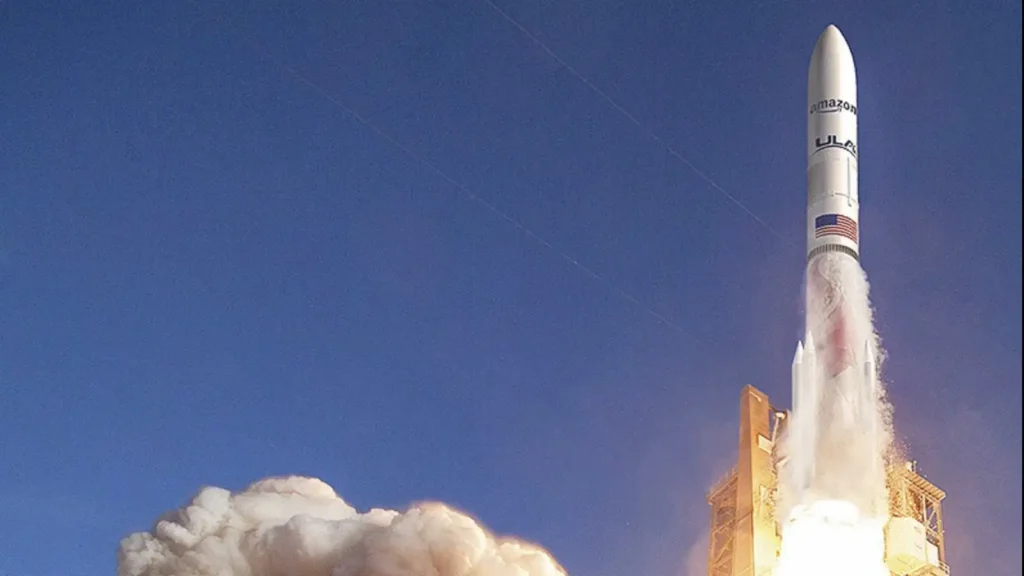Amazon’s Project Kuiper Satellites Enter Space, Challenging SpaceX’s Starlink
Amazon has officially entered the satellite internet race by launching its first batch of 27 satellites for its Project Kuiper initiative. This significant move marks Amazon’s commitment to providing global internet coverage. The satellites were launched aboard a United Launch Alliance (ULA) Atlas V rocket, which successfully deployed them into low-Earth orbit at 630 kilometers. As a result, this launch brings Amazon closer to realizing its vision of connecting underserved areas worldwide.

Breaking Into the Satellite Internet Market
Amazon first unveiled Project Kuiper in 2019, setting the stage for its goal to deploy over 3,200 satellites to provide fast and affordable internet to remote and underserved regions. This launch of 27 operational satellites represents a major leap in the company’s mission to bring high-speed broadband to locations where traditional infrastructure is unavailable.
“We are incredibly proud to take this major step forward with the launch of these satellites,” said Rajeev Badyal, Vice President of Technology for Project Kuiper. “This is a giant leap toward achieving our vision of connecting the most isolated communities to the world’s digital resources.”
Project Kuiper positions Amazon as a direct competitor to SpaceX’s Starlink, which has already launched thousands of satellites into orbit and established a large customer base. However, Amazon’s approach focuses on delivering broadband to areas that struggle with connectivity and bridging the global digital divide.
Amazon’s Strategy to Compete with Starlink
SpaceX’s Starlink has built a massive satellite constellation with more than 6,000 satellites, creating a significant lead in the race for satellite-based internet. But Amazon’s entry with Project Kuiper brings fresh competition. While Starlink mainly caters to individuals and businesses in various regions, Amazon plans to extend the service to the most remote parts of the world where reliable internet is scarce.
The initial batch of Kuiper satellites is only the beginning. Amazon’s vision involves scaling this network to ensure complete global coverage. The company has already booked additional launches and invested significantly in infrastructure to guarantee the success of Project Kuiper.
A Reliable Launch Partner: United Launch Alliance
To transport the first batch of satellites, Amazon chose United Launch Alliance (ULA), a company known for its reliable space missions. The ULA Atlas V rocket successfully launched the satellites into space, marking the beginning of a long-term collaboration between Amazon and ULA.
Amazon’s partnership with ULA will play a pivotal role in ensuring the timely and efficient deployment of future satellite batches. Additionally, the company has secured multiple launches with other providers like Blue Origin and Arianespace, reinforcing its commitment to building a robust satellite network.
Building the Ground Network for Global Connectivity
Satellites are only part of the equation. To ensure that Project Kuiper can deliver high-speed, low-latency internet, Amazon is investing heavily in ground-based infrastructure. The company is developing easy-to-install customer terminals that allow users to connect to the satellite network. These terminals will be designed to be both affordable and user-friendly, ensuring that people in remote regions can access fast internet without complex installations.
In addition to these customer terminals, Amazon is constructing ground stations to facilitate the transfer of data between satellites and earth-based systems. This infrastructure will be critical to optimizing internet speeds and ensuring reliable service as the satellite network continues to expand.
Facing Challenges and Competitors
Even with this promising launch, Project Kuiper is not without its challenges. One of the biggest hurdles is space debris. The rapid expansion of satellite constellations from companies like Amazon and SpaceX could lead to increased risk of collisions in orbit. To mitigate this, Amazon has pledged to follow responsible satellite management practices, including deorbiting older satellites when their operational lifespan ends.
In addition to space debris, Amazon faces strong competition. While SpaceX’s Starlink continues to expand its customer base, other companies like OneWeb are also competing in the satellite internet space. Amazon will need to carefully navigate technical, regulatory, and logistical challenges as it scales Project Kuiper.
What Lies Ahead for Project Kuiper?
Amazon’s next steps involve scaling up the satellite network. The company plans to begin testing its internet services with select customers by 2025, expanding coverage as more satellites are deployed.
If Project Kuiper succeeds, it could revolutionize global connectivity. By reaching remote areas and providing affordable internet access, Amazon could dramatically improve quality of life and open up new economic opportunities for millions of people worldwide. Furthermore, integrating Kuiper with Amazon’s existing services, like Prime memberships and AWS, could provide customers with unique and valuable bundles.
With the launch of its first operational satellites, Amazon has positioned itself as a major contender in the satellite internet race. Over the next few years, Project Kuiper could become a key player in reshaping how the world accesses the internet, offering competition to SpaceX and helping to bridge the digital divide.






